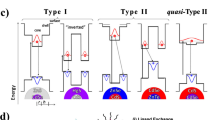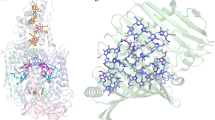Summary
Efficient excited state formation — much higher than that hitherto expected — may occur in organelles and in intact cells. Excited triplet states can be enzymatically generated in high yields by different routes. An example is the oxidation of isobutanal to acetone and formic acid, catalyzed by horseradish peroxidase. Other enzymatic systems that generate triplet carbonyls are linear aliphatic aldehydes when oxidized by peroxidase/O2, or the indole-3-acetic acid/peroxidase/O2-reaction. The latter is widespread in plants.
This new field — photobiochemistry without light — has led to a growing awareness of the idea that cells may utilize excited states to trigger photochemical processes even in the dark. Such phenomena are of considerable importance, also for the understanding of weak photon emission from biological systems.
Similar content being viewed by others
References
Adam, W., and Cilento, G., Eds, Chemical and Biological Generation of Excited States. Academic Press, New York 1982.
Adam, W., and Cilento, G., Four-membered ring peroxides as excited state equivalents: a new dimension in bioorganic chemistry. Ang. Chem. int. Ed. (Engl.)22 (1983) 529–542.
Adam, W., Baader, W. J., and Cilento, G., Enol of aldehydes in the peroxidase-oxidase promoted generation of excited triplet species. Biochim. biophys. Acta881 (1986) 330–336.
Baader, W. J., Bohne, C., Cilento, G., and Nassi, L., Enzymatic generation of triplet acetone: a window to photobiochemistry without light. Biochem. Ed.14 (1986) 190–192.
Baader, W. J., Bohne, C., Cilento, G., and Dunford, H. B., Peroxidase catalyzed formation of triplet acetone and chemiluminescence from isobutyraldehyde and oxygen. J. biol. Chem.260 (1985) 10217–10225.
Cadenas, E., Sies, H., Campa, A., and Cilento, G., Electronically excited states in microsomal membranes: use of chlorophyll-a as an indicator of triplet carbonyls. Photochem. Photobiol.40 (1984) 661–666.
Cadenas, E., Biological chemiluminescence. Photochem. Photobiol.40 (1984) 823–830.
Cilento, G., Electronic Excitation in Dark Biological Processes. Chapter 9 in Adam and Cilento.1..
Cilento, G., Generation of electronically excited triplet species in biochemical systems. Pure appl. Chem.56 (1984) 1179–1190.
Förster, T. H., Mechanism of energy transfer, in: Comprehensive Biochemistry, vol. 22, pp. 61–81. Eds M. Florkin and E. H. Stotz. Elsevier, Amsterdam 1967.
Kenten, R. H., The oxidation of phenylacetaldehyde by plant saps. Biochem. J.55 (1953) 350–360.
Nascimento, A. L. T. O., da Fonseca, L. M., Brunetti, I. L., and Cilento, G., Intracellular generation of electronically excited states. Polymorphonuclear leukocytes challenged with a precursor of triplet acetone. Biochim. biophys. Acta881 (1986) 337–342.
Salim-Hanna, M., Campa, A., and Cilento, G., The α-oxidase system of young pea leaves.Pisum sativum as generator of electronically excited states. Excitation in the dark under natural conditions. Photochem. Photobiol.45 (1987) 695–702.
Sargentini, N. J., and Smith, K. C., Much of the spontaneous mutagenesis inEscherichia coli is due to error-prone DNA repair: implications for spontaneous mutagenesis. Carcinogenesis2 (1981) 863–872.
Schulte-Herbrüggen, T., and Cadenas, E., Electronically excited state generation during the lipoxygenase-catalyzed aerobic oxidation of arachidonates. Photobiochem. Photobiophys.10 (1985) 35–51.
Slawinska, D., and Slawinski, J., Biological chemiluminescence. Photochem. Photobiol.37 (1983) 709–715.
Smith, K. C., and Sargentini, N. J., Metabolically produced ‘UV-like’ DNA damage and its role in spontaneous mutagenesis. Photochem. Photobiol.42 (1985) 801–803.
Venema, R. C., and Hug, D. H., Activation of urocanase fromPseudonoma putida by electronically excited triplet species. J. biol. Chem.260 (1985) 12190–12193.
Villablanca, M., and Cilento, G., Enzymatic generation of electronically excited states by electron transfer. Photochem. Photobiol.42 (1985) 591–597.
White, E. H., Miano, J. D., Watkins, C. J., and Breaux, E. J., Chemically produced excited states. Ang. Chem. int. Ed. (Engl.)13 (1971) 229–243.
Author information
Authors and Affiliations
Rights and permissions
About this article
Cite this article
Cilento, G. Photobiochemistry without light. Experientia 44, 572–576 (1988). https://doi.org/10.1007/BF01953304
Published:
Issue Date:
DOI: https://doi.org/10.1007/BF01953304




